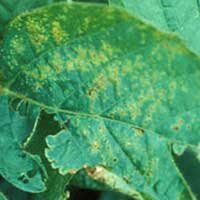
-
Soybean Diseases
- Asian Rust
- Anthracnose
- Bacterial Blight
- Bacterial Pustule
- Bean Pod Mottle Virus
- Brown Stem Rot
- Cercospora Leaf Blight
- Charcoal Rot
- Downy Mildew
- Frogeye Leaf Spot
- Green Stem Syndrome
- Iron Deficiency Chlorosis
- Phytophthora Root & Stem Rot
- Powdery Mildew
- Rhizoctonia
- Seedling Diseases
- Septoria (Brown Spot)
- SCN (Soybean Cyst Nematode)
- Soybean Mosaic Virus
- Stem Canker
- Sudden Death Syndrome
- Viruses
- White Mold
- Soybean Pests
- Diagnostic Help
- Field Trials
- Soybean Library
Your Soybean Checkoff.
Delivering Results.
Illinois
Indiana
Iowa
Kansas
Michigan
Minnesota
Missouri
Nebraska
North Dakota
Ohio
South Dakota
Wisconsin
Bacterial Pustule
Bacterial pustule is a soybean disease caused by the bacterium Xanthomonas campestris pv. glycines. Athough the bacteria is common in the Midwest, it is of minor importance because of the high level of resistance in most commercial soybean varieties. Bacterial pustule can also infect snap beans.
Because this pathogen produces a pustule, it resembles a rust disease. To someone who has not seen soybean rust before, they may assume it to be soybean rust. This is probably the most commonly confused disease with soybean rust.
Disease cycle
Xanthomonas bacteria overwinter on unburied crop residue and on seeds. The bacterial cells are spread during the season by wind-blown rain, rain splashing up from the soil, and during field work when the canopy is wet. The bacteria enter the plant through natural openings and wounds. Unlike bacterial blight, which develops best in moderate temperatures of 70 to 80° F., bacterial pustule develops best during very warm temperatures of 85-90° F., as long as conditions remain wet.
Agronomic impact
Research studies have reported yield loss potential for this disease to range from 4% to as high as 35% under extremely favorable conditions, but bacterial blight rarely reaches high levels of severity in the Midwest. Severe infection may causes some defoliation of young leaves.
Symptoms and scouting
Symptoms begin as small, light green spots that do not appear water-soaked. Light-colored raised blisters (pustules) often develop in the center of lesions on both the upper and lower surface of leaves. The lesions can grow together into large, irregular patches of dead tissue. Loss of tissue in the infected areas may give the leaves a ragged appearance. Small raised spots may also develop on pods.
Look-alikes
Early symptoms of bacterial pustule look similar to bacterial blight. However, bacterial pustule can be differentiated in that the lesions do not appear water-soaked, there is less chlorosis around lesions, and by the formation of tiny tan bumps in the center of the lesions.
The pustules can be mistaken for those of soybean rust, however, bacterial pustules will not have a natural opening in the pustules or masses of spores like those of soybean rust. These features can only be seen under magnification (20 X or higher).
Management
Plant resistant varieties and use pathogen-free seed to prevent bacterial pustule. Rotate soybeans with non-host crops. Plowing and residue management may be beneficial in fields where bacterial pustule is common. Avoid field cultivation when the foliage is wet.
Foliar fungicides will not affect bacterial pustule because it is caused by a bacterial pathogen, not a fungus.
Links
Bacterial Pustule of Soybean - University of Nebraska
Bacterial Pustule - Minnesota Crop Diseases
Bacterial Pustule - Illinois Laboratory for Soybean Disease Research


